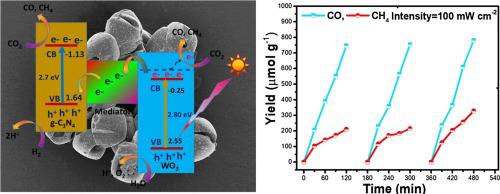Journal of CO2 Utilization ( IF 7.7 ) Pub Date : 2020-08-19 , DOI: 10.1016/j.jcou.2020.101270 Beenish Tahir , Muhammad Tahir , Mohd Ghazali Mohd Nawawi

|
Well-designed 3D/2D WO3/g-C3N4 microspheres with an effective interfacial contact, synthesized through facile single step hydrothermal method, for stimulating photocatalytic CO2 reduction under visible light has been investigated. The direct growth of WO3 microspheres with g-C3N4 enables good interaction among the both semiconductors, enabling proficient charge carrier separation. Highest CO and CH4 production over WO3/g-C3N4 of 145 and 133 μmole g−1 h−1 was achieved, 1.91 and 4.03-fold higher than using pristine g-C3N4, respectively. This enhanced photoactivity was noticeable due to the synergistic effect with the larger interfacial contact area and proficient charge carrier separation. More importantly, CH4 and CO production was increased by 2.51 and 1.64-fold with optimized H2O/CO2 feed ratio due to efficient adsorption of both the reactants. Similarly, by replacing water with H2, CO2 reduction efficiency was increased by 1.5 and 2.6-fold higher for CO and CH4 production. The photon flux also has a significant contribution in CO2 reduction, whereas, 1.6 and 1.7-fold higher CO and CH4 production observed by increasing light intensity. The stability analysis reveals continuous production of CO and CH4 in cycles without any obvious deactivation under both the lower and higher light intensity. This work demonstrates a new approach to construct composite heterojunction and would be beneficial for further investigation in selective CO2 conversion to solar fuels.
中文翻译:

高度稳定的3D / 2D WO 3 / gC 3 N 4 Z方案异质结,用于在可见光下刺激H 2 O / H 2将光催化CO 2还原为CO和CH 4
研究了设计良好的3D / 2D WO 3 / gC 3 N 4微球与有效界面接触的微球,该微球通过简便的一步水热法合成,用于刺激可见光下的光催化还原CO 2。具有gC 3 N 4的WO 3微球的直接生长使两种半导体之间具有良好的相互作用,从而实现了电荷载流子的充分分离。超过WO 3 / gC 3 N 4的145和133μmoleg -1 h -1的最高CO和CH 4产量与使用原始gC 3 N 4相比,分别获得了1.91倍和4.03倍的吸附。由于具有更大的界面接触面积和足够的电荷载流子分离的协同效应,这种增强的光活性是明显的。更重要的是,由于两种反应物的有效吸附,在优化的H 2 O / CO 2进料比下,CH 4和CO的产量分别增加了2.51和1.64倍。类似地,通过用H 2代替水,生产CO和CH 4的CO 2还原效率分别提高了1.5倍和2.6倍。光子通量在CO 2中也有重要贡献减少,而通过增加光强度观察到的CO和CH 4产量分别高1.6和1.7倍。稳定性分析表明,在低光强度和高光强度下,循环产生的CO和CH 4连续产生,而没有任何明显的失活。这项工作证明了一种构造复合异质结的新方法,将有利于进一步进行选择性CO 2转化为太阳能的研究。


























 京公网安备 11010802027423号
京公网安备 11010802027423号